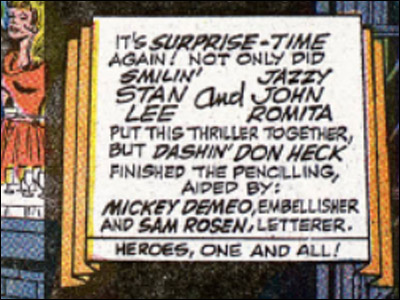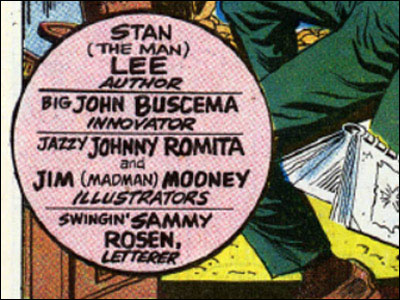Nick Stuart wrote to ask…
Since you know a lot about what artists worked on what specific comics, I'm writing to you to ask a question about the art credits on The Amazing Spider-Man comic in the late 60s and early 70s during a time where it seemed like help was being brought in for John Romita. Artists Romita, John Buscema and Jim Mooney are credited with titles like "innovator" "illustrator" and similar credits that leave it vague as to how the art duties were split up. I was just wondering if you had any knowledge about how the comics were drawn. Did Romita provide layouts for Buscema to finish and Mooney to ink? Did Buscema and Mooney split things up from a layouts/finishes perspective that Romita then made alterations to? Any help at all would be greatly appreciated.
In some ways, Nick, you are trying to know the unknowable. A lot of folks trying to understand how their favorite comics were created try to break it down to something like "Artist A laid out the pages, Artist B finished those layouts in pencil, Artist C inked." Well, maybe. But every possible division of labor could happen on a comic and sometimes, the Who Did What varied from page to page. And when you see credits like "innovator" or "designer," that's probably a matter of whoever wrote the credits being deliberately vague. We do that often on Groo the Wanderer to explain what I do by not explaining.
Credits do not always tell the whole story. For example, before the issues of Spider-Man you mention, there were many which gave sole credit to John Romita for the art and some which listed "Mickey Demeo" (a pseudonym for Mike Esposito) as inker. But almost all of them were inked by both Romita and Esposito. In some cases, John would give certain pages to Mike to ink..and in most cases, the inked pages would go back to John and he'd do retouching or additional inking.
And any issue might have had some background inks by Tony Mortellaro, who worked in the office at a drawing table that was at times, right next to John Romita.
John Romita — and we're talking John Romita Senior here — was unlike many of his contemporaries who drew for Marvel. He worked in the office and was paid a salary to be there. At the time in question, Marie Severin and Herb Trimpe were also on staff but they didn't do as much of what I'm describing as Romita did.

On a given issue of Spider-Man in this period, he could lay it all out, lay out certain pages, tight-pencil certain pages or certain panels, even ink some figures or panels — and then pass it on to someone else like Heck, Mooney, Buscema or Esposito to do more work on those pages. Then they went back to John and he might redraw whatever he thought needed redrawing. Other artists who worked for Marvel at the time like Jack Kirby, Gene Colan, John and Sal Buscema, Don Heck (etc.) did not see the pages at every step of production, nor were they paid to retouch or fix that which they might have felt needed retouching or fixing. Kirby plotted and drew a comic in pencil, turned it in and usually never saw that story until he got a copy of the printed book.
So the correct definition of what Romita did on those issues is "Whatever he felt was needed at whatever stage of production he felt like doing it." And it almost always varied not only from issue to issue but from page to page. There was a very nice period on the book when the credits said Gil Kane was penciling and Romita was inking…but Romita was always involved in the plotting and he almost always erased a lot of what Kane penciled and redrew whole panels.
One other thing I want to mention on this whole matter of art retouching in comics — a practice that was much more common in comics than it is today. A lot of fans when they see evidence of retouch work in a comic assume it means the artist screwed-up and his work had to be fixed. That was not always the case. Redraws might be done because the editor or writer decided to change something about the story. Romita redrew a lot of those Gil Kane panels because though Gil had drawn what he was told to draw, Stan Lee in composing the dialogue for the story, decided he wanted something else in a given panel.
Or something was damaged. Marie Severin used to tell a story about how she had to do major art fixes in a story by another artist because someone in the office spilled a bottle of ink on a job.

And also — and I know this will come as a shock to some of you — editors can be wrong. Everyone I know in comics who ever did art "corrections" at the orders of an editor has told me of times they felt they were "fixing" art which needed no fixing or even that they were making it worse.
At Marvel, Stan Lee was always very nervous about covers and trying to find something — anything! — they could change that might make a cover 1% better. Sol Brodsky, who actually had to execute some of those alterations, called them, "Gratuitous changes." At DC in the sixties and seventies, I thought the Production Department loved tampering with the freelancers' work just because they could. I had the same problem on some TV shows I worked on…someone in power making an unnecessary or even detrimental edit in the show just so they could say, "I saved it!"
Fixes are sometimes necessary but they're sometimes made just because someone wants to be The Boss. Or sometimes, they're just wrong. I've sometimes looked back on a comic book I edited and seen something and thought, "Gee, I should have left that alone."
